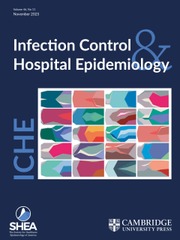No CrossRef data available.
Article contents
Investigation of an Apparent Cluster of Klebsiella pneumoniae Bacteremias Using Random Amplified Polymorphic DNA Analysis
Published online by Cambridge University Press: 02 January 2015
Abstract
A cluster of bacteremia episodes with Klebsiella pneumoniae was noted in patients in a hematology-oncology ward during a 3-week period. Random amplified polymorphic DNA (RAPD) analysis, a novel technique for generating chromosomal fingerprints from bacterial isolates, was used as an aid to the epidemiological investigation of this cluster. For each of the two patients from whom multiple isolates had been obtained, identical RAPD patterns were observed in the serial isolates, even for a patient where the isolates had different biotypes. Isolates from different patients gave distinct patterns. Random amplified polymorphic DNA was found to be a useful typing technique for this cluster of K pneumonia bacteremias.
Information
- Type
- Concise Communications
- Information
- Copyright
- Copyright © The Society for Healthcare Epidemiology of America 1996

